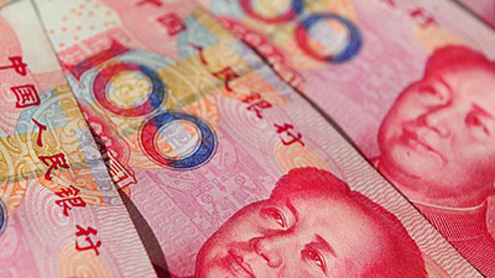
SHANGHAI: The central bank set a precipitously weaker midpoint for the yuan on Monday in reaction to a stronger dollar as uncertainty in Europe and a series of bank credit rating downgrades encouraged markets to seek shelter in dollar assets.
The People’s Bank of China set the yuan midpoint at 6.3230, nearly 2 basis points weaker than the prior setting, marking a decline of 0.3 percent, the most abrupt day-on-day drop since mid-March. Spot yuan continued their custom of pricing below the midpoint, opening down at 6.3720 then diving further to trade briefly at 6.3827, the yuan’s weakest trade against the dollar since November 29, 2011. However, spot prices bounced off this low quickly and resumed trading slightly below the opening level.
“Before today the yuan was moving between 6.35 to 6.36, but now it is fundamentally moving above 6.37,” said a trader at a large Chinese bank in Beijing.
The drastic nature of the drop was in part due to a three-day weekend in China.
Chinese markets were closed on Friday for a public holiday, when the dollar index – which Beijing frequently refers to when setting the yuan midpoint – rose by 0.9 percent against a basket of currencies in overnight trading. It rose again slightly the next trading day.
In addition, the spot market had consistently rejected strong fixings by the central bank, which traders believed were intended to signal markets that the government would not permit drastic downward moves in the exchange rate. On Thursday, spot yuan traded 0.98 percent away from the midpoint, a new record wide divergence, and only 2 basis points away from the 1 percent trading band limit.
As a result, traders said the central bank was forced to push down the yuan abruptly on Monday to catch up with the decline in the market after effectively skipping two US trading days.Traders told Reuters that the rise in the dollar index – and by extension the drop in the yuan – was due to reduced expectations that the US will launch a third found of quantitative monetary easing (“QE3”), which would put downward pressure on the dollar. “I don’t think (the drop in the yuan) exceeded market expectations,” said a trader at a foreign bank in Shanghai.
He said that the yuan was beginning to find bottom, noting that the gap between the spot and the fix had narrowed since Thursday. “Last Thursday the spot was about 600 pips away from the fixing, today it is less, around 500 pips. There is buying interest from clients who might think that 6.37, 6.38 is already too high (weak) for the yuan. We will find some balance in the market.”
What that balance will be is a matter of some disagreement. While many economists predict that the yuan will appreciate slightly by the end of 2012, albeit by only 1-2 percent, some traders told Reuters they believe outright depreciation is in the cards, as reflected by the price of 1-year non-deliverable forwards, which continue to trade at a discount to spot prices.
The dollar index hit its highest point since August 2010 on June 1 as investor confidence in the viability of the euro zone and in the robustness of the Asian economic recovery has waned. The dollar index remains at its highest point since September 2010. At the same time, the yuan remains at a decade-high against the euro, putting additional negative pressure on demand for Chinese goods alongside the general economic slowdown in Europe.-Becorder












